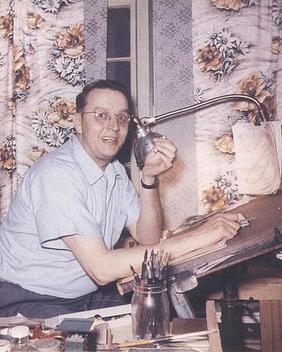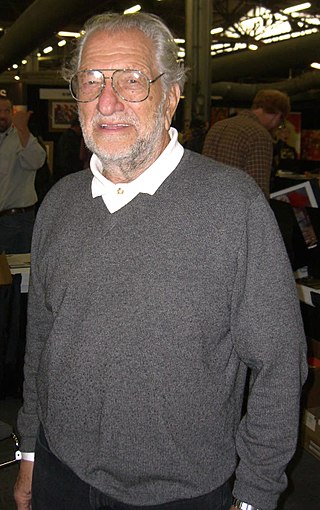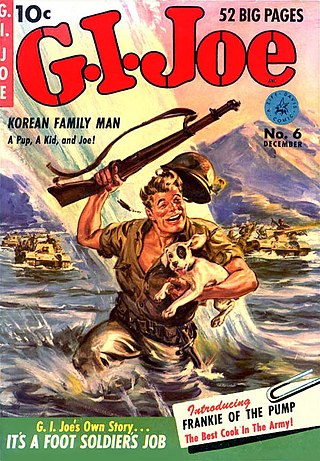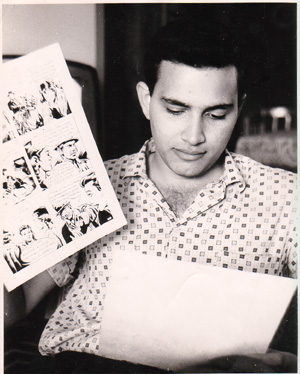
William Erwin Eisner was an American cartoonist, writer, and entrepreneur. He was one of the earliest cartoonists to work in the American comic book industry, and his series The Spirit (1940–1952) was noted for its experiments in content and form. In 1978, he popularized the term "graphic novel" with the publication of his book A Contract with God. He was an early contributor to formal comics studies with his book Comics and Sequential Art (1985). The Eisner Award was named in his honor and is given to recognize achievements each year in the comics medium; he was one of the three inaugural inductees to the Will Eisner Comic Book Hall of Fame.

Jack Ralph Cole was an American cartoonist best known for birthing the comedic superhero Plastic Man, and his cartoons for Playboy magazine.

Crazy Magazine is an illustrated satire and humor magazine that was published by Marvel Comics from 1973 to 1983 for a total of 94 regular issues. It was preceded by two standard-format comic books titled Crazy. The magazine's format followed in the tradition of Mad, Sick, Cracked and National Lampoon.

The Spirit is a fictional masked crimefighter appearing in American comic books. Created by cartoonist Will Eisner, he first appeared as the main feature of a tabloid-sized comic book insert distributed in the Sunday edition of Register and Tribune Syndicate newspapers. Popularly referred to as "The Spirit Section", the insert ran from June 2, 1940 to October 5, 1952.

Joseph Kubert was a Polish-born American comic book artist, art teacher, and founder of The Kubert School. He is best known for his work on the DC Comics characters Sgt. Rock and Hawkman. He is also known for working on his own creations, such as Tor, Son of Sinbad, and the Viking Prince, and, with writer Robin Moore, the comic strip Tales of the Green Beret.

Eduardo Risso is an Argentine comics artist. In the United States he is best known for his work with writer Brian Azzarello on the Vertigo title 100 Bullets, while in Argentina and Europe he is noted for his collaborations with Ricardo Barreiro and Carlos Trillo. He has received much acclaim for his work.

Kitchen Sink Press was a comic book publishing company founded by Denis Kitchen in 1970. Kitchen Sink Press was a pioneering publisher of underground comics, and was also responsible for numerous republications of classic comic strips in hardcover and softcover volumes. One of their best-known products was the first full reprint of Will Eisner's The Spirit—first in magazine format, then in standard comic book format. The company closed in 1999.

Emil Samuel "Zeke" Zekley was an American cartoonist who worked on several comic strips, notably George McManus's Bringing Up Father.

Murphy C. Anderson Jr. was an American comics artist, known as one of the premier inkers of his era, who worked for companies such as DC Comics for over fifty years, starting in the Golden Age of Comic Books in the 1940s. He worked on such characters as Hawkman, Batgirl, Zatanna, the Spectre, and Superman, as well as on the Buck Rogers daily syndicated newspaper comic strip. Anderson also contributed for many years to PS, the preventive maintenance comics magazine of the U.S. Army.

Richard Bache Ayers was an American comic book artist and cartoonist best known for his work as one of Jack Kirby's inkers during the late-1950s and 1960s period known as the Silver Age of Comics, including on some of the earliest issues of Marvel Comics' The Fantastic Four. He is the signature penciler of Marvel's World War II comic Sgt. Fury and his Howling Commandos, drawing it for a 10-year run, and he co-created Magazine Enterprises' 1950s Western-horror character the Ghost Rider, a version of which he would draw for Marvel in the 1960s.
Comic Book Artist was an American magazine founded by Jon B. Cooke devoted to anecdotal histories of American comic books, with emphasis on comics published since the 1960s. It was published by TwoMorrows Publishing and later Top Shelf Productions from 1998–2005. Its sequel is Comic Book Creator magazine which started publishing in 2013 and is also published by TwoMorrows.
Michael G. Ploog is an American storyboard and comic book artist, and a visual designer for films.

Gary Friedrich was an American comic book writer best known for his Silver Age stories for Marvel Comics' Sgt. Fury and his Howling Commandos and in the following era, the series The Monster of Frankenstein, as well as for cocreating the supernatural motorcyclist Ghost Rider and the supernatural hero the Son of Satan.

Maggie Thompson, is an American longtime editor of the now-defunct comic book industry news magazine Comics Buyer's Guide, science fiction fan, and collector of comics.
"Charles Nicholas" is the pseudonymous house name of three early creators of American comic books for the Fox Feature Syndicate and Fox Comics: Chuck Cuidera (1915–2001), Jack Kirby (1917–1994), and Charles Wojtkoski (1921–1985). The name originated at Eisner & Iger, one of the first comic book packagers that created comics on demand for publishers entering the new medium during the 1930s–1940s Golden Age of comic books. The three creators are listed in order of birth year, below.

War comics is a genre of comic books that gained popularity in English-speaking countries following World War II.

Francisco Chiaramonte was an American comic book artist best known as an inker for DC Comics and Marvel Comics from 1972 to 1982.
Klaus Nordling was an American writer-artist for American comic books. He is best known for his work on the 1940s masked-crimefighter feature "Lady Luck", and as co-creator of the Marvel Comics superhero the Thin Man. Some of the early Nordling's pen names are Fred Nordley, F. Klaus, Ed Norris, and Clyde North.
Desperado Publishing is an American independent comic book publisher, established in 2004. Located in Norcross, Georgia, Desperado's president is Joe Pruett, its creative director is Stephan Nilson, and its director of business development is former Caliber Press publisher Gary Reed.

Government comics include informational material produced in comic book-format by governments and their affiliated bodies. These works fulfill a wide variety of purposes often seen in government publications, primarily educating the public about government programs or lifestyle choices the government wants to encourage. Richard L. Graham examines and dissects the United States' government comics in Government Issue: Comics for the People, 1940s-2000s.


















